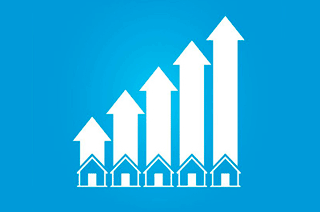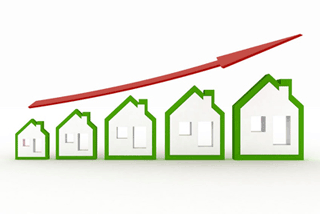Quote of the Week
“People are seeing these very low fixed rates – often just a little over 2% – at major banks and no wonder they are attracted. In turn, the banks have the comfort of knowing what monetary policy is very likely to be for a long period of time.”
Steve Mickenbecker, group executive financial services at research agency Canstar
Regional House Prices Surge Upwards
 Property prices in regional Australia are surging upwards while the median dwelling value for the combined capital cities fell in the last three months, according to the Domain House Report for the June Quarter.
Property prices in regional Australia are surging upwards while the median dwelling value for the combined capital cities fell in the last three months, according to the Domain House Report for the June Quarter.
Canberra and Hobart were the capital cities to record an increase in median house prices in the quarter with Canberra up 2.8% and Hobart up 0.9%, while Adelaide recorded no change.
“Regional areas typically do not provide the big swings of cities, and do provide homeowners with steady capital growth,” Domain senior research analyst Nicola Powell says.
Regional markets are less reliant on overseas and interstate migration, which had been brought to a standstill by coronavirus, she says.
Year-on-year, the biggest price changes in each state were in the LGAs of : (1) Isaac, Central Qld where prices rose 32%; (2) Leeton, NSW which recorded a 23% increase; (3) Huon Valley, Tasmania which notched up an extra 22%; and (4) Colac Otway, Victoria where an uplift of 19% was recorded.
Rents Rise As National Shortage Bites
 Rents are rising across the nation as undersupply bites, according to research by industry expert Propertyology.
Rents are rising across the nation as undersupply bites, according to research by industry expert Propertyology.
Propertyology’s head of research Simon Pressley says that 39 of Australia’s 52 largest towns and cities – 75% of the total – have an undersupply of properties. Only four out of 52 major Australian cities and towns have a residential vacancy rate of 3% or higher (as at 30 June).
Five out of the eight capital cities have shortages undersupplied though Sydney and Melbourne remain oversupplied, along with the Gold Coast (4%) and Geelong (3.5%).
Propertyology says a market with a balanced supply has a vacancy rate between 2–3%. Vacancy rates above 3% mean there are more choices for tenants, which places downward pressure on rent prices.
“The only thing currently preventing an official declaration of an Australian rental crisis is the sedation effect of the coronavirus containment measures,” Pressley says.
He suggests the shortage has been caused by the low number mum-and-dad investors buying properties in the past year or two.
HomeBuilder Grant Drives Land Sales
 The Federal Government’s new homebuyer grant has seen interest in vacant land sales increase by 60% in June, according to figures from realestate.com.au.
The Federal Government’s new homebuyer grant has seen interest in vacant land sales increase by 60% in June, according to figures from realestate.com.au.
The increase follows the announcement of the Federal Government’s HomeBuilder scheme which provides eligible owner-occupiers (including first-home buyers) with a grant of $25,000 to build a new home or substantially renovate an existing home”.
Real estate agents reveal there has been a strong response from first-time buyers with enquiries for vacant land from this cohort increasing 180%, compared to homeowners rising by 35% and investors just 26%.
“It’s obviously going to be very positive for the construction sector,” REA Group director of economic research Cameron Kusher says.
Increased property market activity largely occurred outside New South Wales, which recorded a rise of 55%.
It is suggested the $750,000 limit is an unrealistic requirement given Sydney’s high property prices.
Build-to-rent About To Boom
 The build-to-rent sector is on the cusp of a boom as lifestyle choices change and home ownership becomes more difficult for some.
The build-to-rent sector is on the cusp of a boom as lifestyle choices change and home ownership becomes more difficult for some.
Build-to-rent (BTR) is an alternative development model where a development company holds stock in its project specifically for long-term rentals rather than sell off the individual units. The concept has proven popular in America and the UK.
According to a CBRE report, the Australian BTR development pipeline recently passed 11,000 units with investors favouring assets delivering reliable income streams amid the coronavirus pandemic.
Over the past 12 months, 30 major BTR projects with an average size of 365 apartments totalling 11,667 were confirmed. Another 10,000 BTR units are in planning.
Offshore institutional funding accounts for 50% of the total pipeline, signalling the global attraction of the stable cash flow from BTR in a low-yield environment, CBRE’s associate director of structured transactions and advisory Puian Mollaian says.
“The sector is bound to experience some significant growth in the coming years, although we’re starting from a very low base,” he says.
More Aussies Now Live in Units
 More Australians are living in apartments, with one in five now residing in strata-titled properties, according to a new report from UNSW’s City Futures Research Centre.
More Australians are living in apartments, with one in five now residing in strata-titled properties, according to a new report from UNSW’s City Futures Research Centre.
Since being introduced in Australia in 1961, strata title property ownership has grown to almost 3 million today. In 2015 the number of new apartments overtook the number of new detached houses for the first time in Australia’s history.
“This increase reflects the population growth, especially pronounced in the larger urban areas, as well as government policies to promote urban consolidation – that is, building up, rather than out – within existing urban areas,” says Associate Professor Hazel Easthope who led the project.
Alisha Fisher, CEO, Strata Community Association Australasia, says: “The data shows just how important strata-titled living is to Australia as people place increased value on access to their places of work, shopping and entertainment precincts, and recreational amenities either within the surrounding community or the strata complex.”




